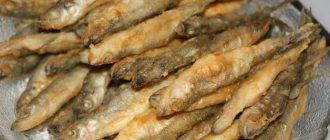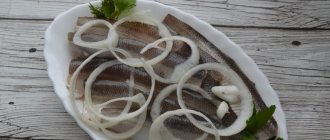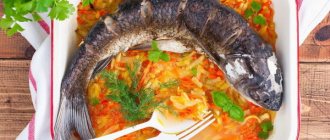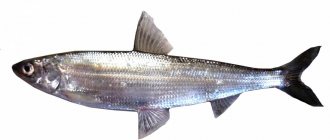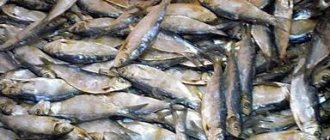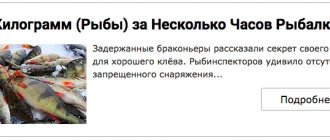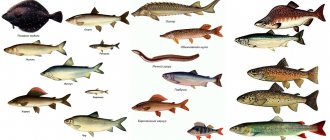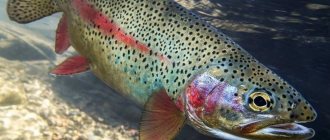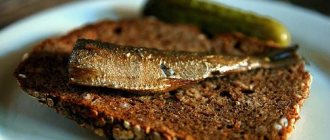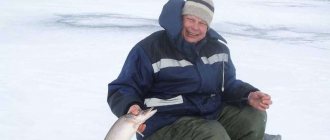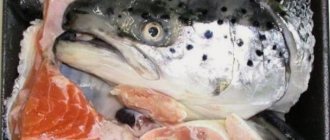vendace
- freshwater fish from the Salmon family. Varieties of vendace: European, Siberian and coregonus albula, which in our country is also known as the “Pereslavl herring”, although it has absolutely nothing to do with herrings, except that it is somewhat similar in appearance.
The size of vendace is 13-20 centimeters. Particularly large individuals can reach 35 centimeters in length. The shape of vendace resembles a herring, its body is somewhat compressed on the sides, the upper jaw is shorter than the lower jaw, and there is a notch on the lower jaw. The body of the fish is covered with large scales, the sides are silvery, the back is gray-blue, and the belly is white. The fins of the fish are white, except for the dorsal and caudal fin, which are gray.
Appearance and varieties
European vendace
Vendace as a species of the whitefish genus has subspecies:
- European vendace
. The Pereslavl species is distinguished separately, but in fact it belongs to the European subspecies; - Siberian vendace
; - Belomorskaya
.
European vendace
popularly known as kilets, or ripus. The average size of this fish is from 13 to 20 centimeters, but the maximum recorded length of its body was 35 centimeters and weighed about 1000 grams. The body shape of the fish resembles a herring: it is flattened on the sides, and there is a notch on the lower jaw. The lower jaw also extends beyond the upper. The scales are quite large, but 91–96 scales fit in a row on the lateral line. The back is painted blue with a gray tint, the belly is white, the caudal and dorsal fins are gray, the remaining fins are painted white or another color close to white.
The vendace, which lives within Siberia, has a similar appearance. Even its dimensions remain the same: vendace grows up to 35 centimeters, and its weight does not exceed 1 kilogram. This type of fish lives up to 12 or 15 years. And it reaches reproductive age at 6 years, when body weight reaches 200 grams.
White Sea vendace has the smallest size: it is no more than 25 centimeters in length and weighs no more than 300 grams. The bulk of the fish is about 16–17 centimeters in length and 50 grams in weight. If it lives in a lake, then the size of the vendace becomes even smaller. The body of the White Sea vendace is narrow, the back is flatter, and the belly is convex. The body color is the same as that of other species of vendace, with the exception of the fins, which are painted white, and only their tip is blackish. The fish's mouth is facing upward.
Vendace in cooking. How to cook vendace deliciously
Photo: vendace fish
The Pleshcheyevo (Pereslavl) vendace is now spoken of as the most valuable, but - alas! – an almost lost delicacy. Well-cooked vendace emits a thick and appetizing smell: it is good in soup, in pies and casseroles, in okroshka and other dishes that can be considered gourmet in our time. Fried and smoked, it is especially tasty - you can eat it “tirelessly”, and here it has “no equal”.
You can still buy vendace, but today it is not so cheap: fresh frozen - 220-300 rubles / kg, smoked - about 500 rubles / kg, and dried - about 700 rubles / kg.
Photo: vendace fish
Dried vendace is very tasty and appetizing
– you can learn how to dry it at home. Fresh or defrosted fish should be salted with seasonings to taste, left for 2-3 days, and then transferred to lightly salted brine for several hours: the excess salt from the fish will get wet, and there will be no white coating left on its surface after drying. Next, the fish is thoroughly washed so that no mucus or salt remains, strung on strong twine or wire, and hung to dry in a ventilated, dry place. It is better to dry fish in spring or autumn, when there are few flies, but if desired, the product can be protected from them using simple devices, which are a frame covered with a net or gauze. The vendace does not dry for long - on the 5th day it is already completely ready; it should be stored in the refrigerator or simply in a cool place, in a paper or cloth bag.
Fresh vendace is usually fried
: This is the best cooking method, allowing you to get the most delicious and healthy from its meat. Fish (1 kg) must be thoroughly washed - almost all of its scales are washed off with water - rolled in flour mixed with salt and spices, and fried on both sides in a small amount of oil until golden. Flour (5 tbsp - preferably rye or corn) is mixed with 1/2 tsp. sea salt and freshly ground black (red, pink) pepper to taste. When serving, sprinkle the fish with finely chopped green onions.
You can prepare “disposable” horseradish for fried vendace: grate the peeled and washed root on a fine grater, add salt and sugar to taste and pour freshly squeezed lemon juice over everything in a cup. Everyone who has tried fried vendace claims that this dish is truly royal. Particularly delightful is the vendace, fried in butter and breaded with crushed crispbread.
The most delicious vendace soup is also prepared simply and quickly, in 25-30 minutes. Place 3-4 chopped potatoes in a pan of boiling water (1.5 l); after boiling the water again, add onions and fish, cut into large pieces; cook for another 15 minutes. You need to salt and add spices a few minutes before the dish is ready. In plates, the fish soup is sprinkled with fresh herbs.
There are no contraindications to the use of vendace
. Only those who suffer from allergies to various foods should be careful.
Author: Gataulina Galina
Article protected by copyright and related rights. When using or reprinting material, an active link to the women's website www.inmoment.ru is required!
Tags: vendace fish, how to cook vendace at home
Return to the beginning of the Healthy body section Return to the beginning of the Beauty and Health section
Encyclopedias
European vendace (Kelets, ripus) is a freshwater fish belonging to the whitefish genus. Varieties of vendace: Siberian, European and coregonus albula, which in our country is sometimes mistakenly called “Pereslavl herring”, despite the fact that it has nothing to do with herrings, except, perhaps, for a slight external resemblance.
Distribution and habitats
Pereslavl vendace
The European species of vendace lives mainly in lakes, but it is often found in rivers, as well as in the bays of the Baltic and the sea: in the Finnish and Bothnian. Vendace loves to stay on a clay or sandy bottom and avoids warm water. You can meet it in Finland and in the northern regions of Russia, Denmark, Scandinavia, Scotland, Germany, Belarus and Lithuania. The Pereslavl species is found exclusively in Lake Pleshcheyevo.
Pereslavl vendace
lives in the only lake called Pleshcheyevo. It is located in the southern region of the Yaroslavl region: this vendace is cold-loving, since it ceases to feel comfortable already at a water temperature of +16...+17 degrees Celsius. Due to anthropogenic impact, vendace in Lake Pleshcheyevo is observed only at certain horizons that meet the requirements regarding water temperature and its oxygen saturation. You can find it at a depth of 10–25 meters, but with sunset it is found higher. Recently, individuals in the lake began to grow very slowly, and their average life expectancy decreased by 2 years.
Siberian vendace
lives in the Laptev Sea basin. This vendace is considered a typical migratory fish that can live in very salty water, but during the spawning season it rises into rivers. The White Sea species is found in sea basins belonging to the Arctic Ocean. Such vendace is popularly called herring, or Zelda.
Where is it found?
Vendace prefers to live in clean lakes. Lives in reservoirs belonging to the basins of the Baltic, White, and Barents seas. A unique place where the European variety overlaps the range of the Siberian one is the Pechora River basin. From the south, the border of the habitat of the European species of this fish runs along Lake Peipsi and the deep-water lakes adjacent to the upper reaches of the Volga. A tendency has been noticed that vendace has begun to descend lower and is already found in the Saratov reservoir and lakes of Belarus. The most famous places where it is found in such quantities that it is worth going fishing even from afar are the following lakes:
- Ladoga;
- Onega;
- Uvildy;
- Ingol.
Large species - rhipus and kilets - are less common. They are protected by the state. During spawning, recreational fishing for vendace is prohibited. The timing of spawning depends on where the fish live.
In northern latitudes it begins earlier - already at the end of September, and mass spawning - from mid-November. The eggs will develop until spring. It is in the spring that the eggs are in danger of being hatched by other fish.
European vendace differs in appearance from Siberian and White Sea vendace. The Siberian one is larger, and the White Sea one is smaller. The average life expectancy is 7 – 12 years. European and Siberian vendace reaches a weight of 200 g only at the age of 6 years. By this time, she is able to reproduce.
The weight of the White Sea vendace rarely exceeds 300 g. More often, individuals in the catch are no larger than 50 g. A photo of a single individual does not reflect the size, but a massive catch demonstrates how small a fish it is.
Outwardly, it looks like a bleak: the body is narrow and elongated. The abdomen is slightly convex, and the back is almost straight (unlike the Siberian and European). The fins of the White Sea vendace do not have a clear border, but darkening is visible at the tips.
In Lake Pleshcheyevo there is a species that is not found anywhere else. This is Pereslavl vendace , which does not like warm water and feels comfortable only at a temperature not exceeding 17°C. During the day it stays at a horizon of 10–20 m, at night it rises higher. With climate change, the life expectancy of Pereslavl vendace has decreased and growth has slowed. The fish was included in the Red Book.
Diet and lifestyle
White Sea vendace
European and Siberian vendace feed on small crustacean organisms such as cyclops and daphnia. To hunt them, ripus comes out in schools to shallow depths. The White Sea vendace uses not only zooplankton for food, but also small insects. The larvae of these same insects are also eaten.
All individuals, with the exception of those from Pereslavl, become sexually mature at approximately 6 years of age. The Pereslavl vendace acquires reproductive functions at the age of two or three. The spawning period is very short, and it begins at the end of autumn, and sometimes ends in winter. The female lays yellow eggs on the sandy or muddy bottom. Its fertility is approximately 7–18 thousand eggs with a diameter of 1.5 millimeters.
Benefits and properties
Vendace meat, despite the fact that it is a freshwater fish, contains a fairly large number of omega-3 polyunsaturated fatty acids. However, in the meat of this fish they disintegrate too quickly, which is the reason for the relatively rapid spoilage of this fish; vendace remains fresh, even if stored in ice, for no more than a day. This quality was the reason to make vendace from Lake Pleshcheevo in Pereslavl-Zalessky a royal dish, because during transportation to Moscow it should not have lost its freshness and the characteristic aroma of a fresh cucumber.
Indeed, in the 15th-17th centuries, vendace was exclusively royal food, which was even part of the coronation ritual for the Moscow principality and the kingdom. The choice of the princes was based on the fact that the nutritional properties of vendace provided adequate nutrition not only to the heart and muscles, but also to the brain.
For long-term storage or long-distance transportation, vendace is subjected to a deep-freezing procedure, due to which, if the freezing technology is followed, all its beneficial qualities are preserved for a long time. The combination of elements such as magnesium and histidine ensures that vendace meat stimulates the functioning of the immune and nervous systems of the human body.
The small size is compensated by the fact that vendace has very few bones - no more than 9%. All the beneficial properties of vendace are preserved even when it is smoked and salted.
Fishing for vendace
Siberian vendace
In summer, vendace is caught from a boat and from the shore. From the shore - with a bottom tackle, fly rod or Bolognese rod, and from a boat - with an onboard fishing rod equipped with a nod. Float tackle is not the best way to purposefully catch these fish, which are caught by chance.
The most interesting is winter fishing. From the ice, vendace is caught using a garland, a jig and a hook. The nod is given firmly. Fishing takes place at a depth of more than 20 m, so in windy weather there is nothing to do on the ice without a tent. Where vendace is found, locals set up houses on the pond and fish comfortably.
Interesting information
Vendace, which is found in Lake Pleshcheyevo, was not only part of the coronation dinner, but was also included in the Lenten menu of the royal persons. Large and fatty fish from this lake, which was also called (“Pereslavl herring”), in the 16th century, according to the tsar’s decree, could not be caught or, moreover, sold; for such an offense, Tsar Alexei Mikhailovich, concerned about the state of vendace stocks, threatened the fishermen with the death penalty to the elders.
Smoked vendace is featured on the official coat of arms of the city of Pereslavl-Zalessky.
And in Finland, at every street festival you can see how the Finns’ favorite fish, vendace, is cooked in a huge frying pan, after having rolled it in rye flour. Vendace is fried in Finnish rep oil, making sure to add butter during the cooking process.
Description
Vendace is of interest from a consumer point of view. It is used to make fish soup, bake it in the oven, use it as a filling for pies and dumplings, salt it, dry it and smoke it. Fishermen are attracted by the taste and the fishing process. Its other names: ripus, kilets. Vendace rarely appears in stores - its true connoisseurs know what kind of fish it is.
The standard size is 20 cm, sometimes specimens are found with a length of 30 cm. This is one of the smallest representatives of whitefish in Europe. If we draw parallels and compare it with other fish, then the similarity with herring is noticeable. Previously, vendace was called that way - herring, but they only added the definition - royal. The photo allows you to verify the similarity.
In Russia, vendace is represented by several species:
- European;
- Siberian;
- Belomorskaya;
- Pereslavskaya.
The fish's head is small, cone-shaped. The body is herring-shaped. The scales are not that large, but in other whitefish they are much smaller. The adipose fin indicates that it belongs to the whitefish. It is located on the back between the tail and the dorsal fin.
The lower jaw is slightly pushed forward. The body of the fish is laterally compressed. The abdomen is convex. The weight that is considered a worthy catch is from 350 g to 400 g. The back is darker than the belly, with a blue or greenish tint. The fins are edged with a dark color.
